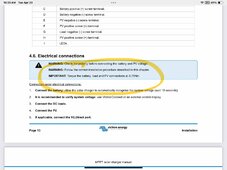Samsonite801
Solar Wizard
- Joined
- Oct 15, 2020
- Messages
- 2,994
Edit to add, I use a regular driver for other connections but that Capri will mentioned looks really nice and may be on my list (you can never have to many tools)...
I have a special technique for screwdrivers and nut drivers, where it involves your grip, and using a controlled slippage method (up to proper torque), as I'm approaching proper screw torque, I am gripping onto the screwdriver handle with only a certain level of tension (as I am turning it in), and when the screw arrives at proper torque, the screwdriver starts to slip on my palm grip, and I keep trying to turn it each time and the palm just slips more and more until I get total slippage on every turn attempt. Then I know it is at right torque. The actual torque spec depends on how much controlled slippage you allow. I'd say it's both grip tension and heart intuition (mind/body/spirit/soul synergy).
WARNING:
Please do not try this at home unless you understand the technique well, until you can know that you can get same torque as with a special screwdriver. It took me since I was 10 years old through now, to learn the technique described here.




